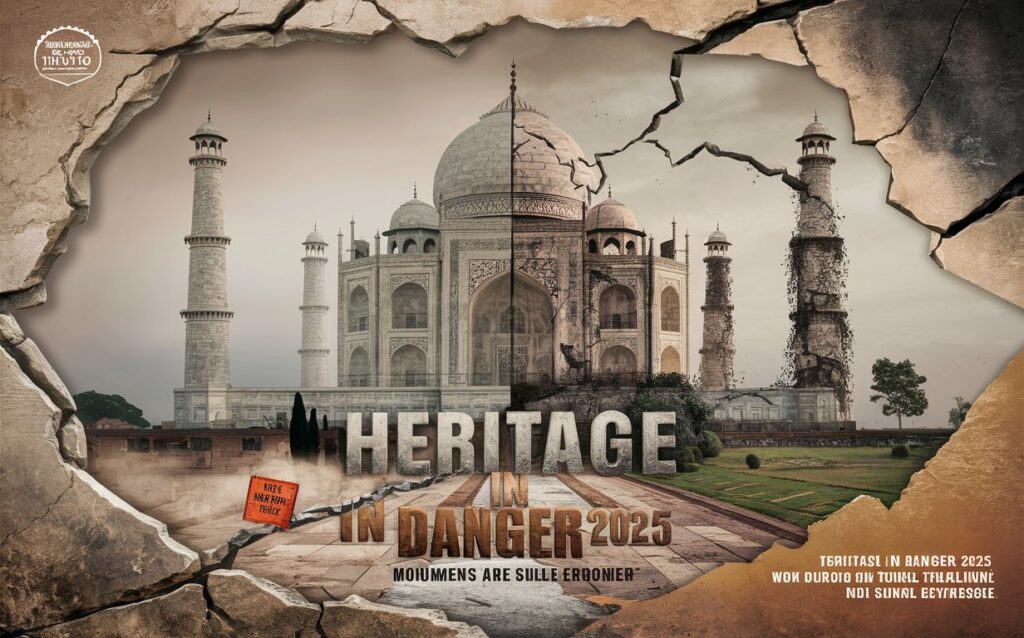🏛️ Indian Monuments Under Threat 2025: The Silent Erosion of Heritage
India’s timeless beauty lies in its historical monuments — from the Taj Mahal to Hampi, from Ajanta caves to Qutub Minar. But in 2025, these national treasures face a rising tide of threats: pollution, climate change, unchecked tourism, and government negligence. The erosion of these sites is no longer symbolic — it’s physical, visible, and irreversible unless action is taken now.

🏰 Pollution: Eating Monuments From the Outside
Air pollution in cities like Delhi, Agra, and Varanasi is corroding stone faster than nature ever could. The Taj Mahal’s white marble is turning yellow and green due to sulfur dioxide and industrial smoke.
Historic mosques and temples near highways or industrial zones suffer daily chemical attacks that wear down intricate carvings and paintwork. Even acid rain in northern India is causing discoloration and cracking in sandstone structures.
🌊 Climate Change: Nature’s War on Heritage
From rising sea levels threatening coastal forts like Sindhudurg and Fort Aguada, to heatwaves cracking the walls of Rajasthan’s desert forts, climate change is India’s new heritage vandal.
Unseasonal rains and flooding damaged dozens of structures in Uttarakhand and Madhya Pradesh in early 2025.
The Konark Sun Temple is seeing sea salt corrosion at a faster rate, while Meenakshi Temple faces seasonal flooding never recorded before.
🚶 Uncontrolled Tourism and Human Damage
India welcomed 15.4 million foreign tourists in 2024. Domestic footfall crossed 180 million. Without proper crowd control, monuments are deteriorating under physical stress.
Foot traffic erodes floors, careless visitors scratch walls, and selfies turn dangerous with people climbing forbidden areas.
In 2025, Hampi lost 40 square meters of its structure due to repeated physical tampering and illegal encroachments.
🧱 Illegal Construction and Urbanization
Urban sprawl is creeping dangerously close to protected zones. In Hyderabad, builders have illegally raised apartment complexes near Golconda Fort, violating ASI restrictions.
The Red Fort’s buffer zone in Delhi is now surrounded by parking lots, tea stalls, and unauthorized markets. Monuments once isolated in glory are now choking in city smog and construction dust.
🧾 Government Response: Too Little, Too Late
While the Archaeological Survey of India (ASI) maintains over 3,600 monuments, budget cuts and understaffing have reduced on-ground protection.
In 2025, ASI admitted that over 200 monuments are now ‘beyond repair’, including lesser-known gems in Assam, Odisha, and Manipur.
The newly launched “Adopt a Monument 2.0” scheme allows private companies to fund conservation, but critics say heritage must not be commercialized.
🧠 AI and Tech to the Rescue
To combat decay, India is experimenting with 3D scanning, virtual tourism, and AI-based restoration modeling. IITs and global universities are helping digitally map vulnerable sites for future repairs and archiving.
Startups like HeritEdge and Preservia are using drone surveillance to detect micro-cracks and unauthorized damage in real-time.
📚 What Citizens Can Do
- Visit responsibly. Avoid touching or climbing fragile sections.
- Report vandalism or illegal activity using the Monument Watch App.
- Spread awareness in schools and colleges.
- Support NGOs working in heritage conservation.
✅ Conclusion
India’s monuments are not just tourist attractions — they are silent storytellers of centuries past. If ignored, we risk losing them forever. 2025 must become the year of urgent preservation, responsible tourism, and a deep national commitment to protecting the soul of our civilization. 🛕🇮🇳



Post Comment